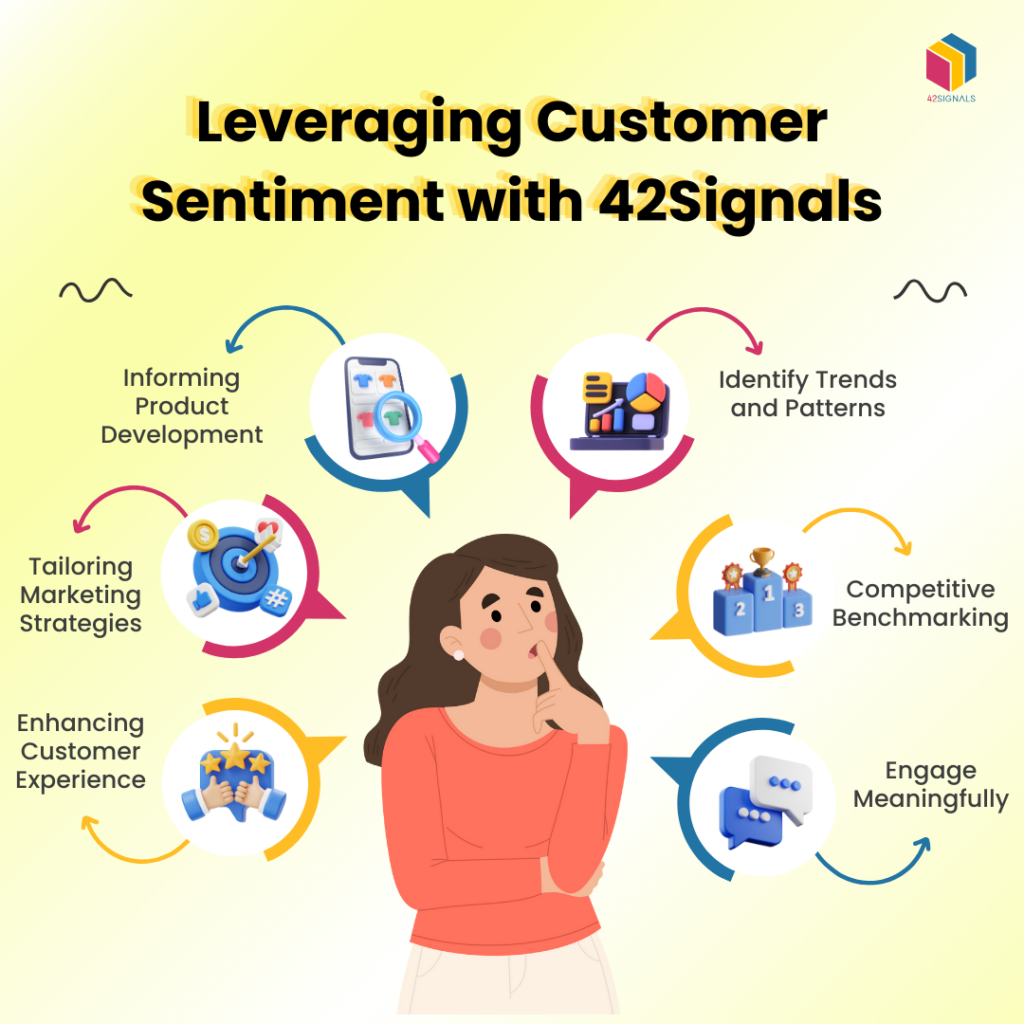Positive vs negative sentiment analysis offers unique insights that can drive strategic decisions, enhance customer satisfaction, and boost brand loyalty. With advanced tools like 42Signals, businesses can efficiently analyze and leverage customer sentiment to stay ahead of the curve. This article delves into the importance of customer sentiment, how to analyze it, and the ways 42Signals can help you leverage these insights.
What is Customer Sentiment?
Customer sentiment refers to the emotions and opinions expressed by customers about a brand, product, or service. These sentiments can be broadly categorized into positive, negative, and neutral. Positive sentiment indicates customer satisfaction and loyalty, while negative sentiment points to dissatisfaction and potential churn. Neutral sentiment often provides a balanced view, highlighting strengths and improvement areas.
How to Assess Positive vs Negative Sentiment?
1. Positive Customer Sentiment
Positive customer sentiment indicates that a customer has had a favorable experience with a brand, product, or service. When customers express positive sentiments, they are more likely to become repeat customers, recommend the brand to others, and leave positive reviews online.
By identifying and analyzing these positive sentiments, businesses can gain valuable insights into what works well and replicate those successes across their offerings. With 42Signals, businesses can track positive mentions, analyze customer feedback, identify key themes, and monitor social media conversations to stay informed about their positive reputation.

2. Negative Customer Sentiment
Negative customer sentiment signifies dissatisfaction or disappointment with a brand, product, or service. While no business wants to deal with unhappy customers, negative sentiments provide essential opportunities for growth and improvement.
By addressing these issues promptly and effectively, businesses demonstrate their commitment to providing excellent customer experiences and building trust with their audience. Using 42Signals, companies can detect negative mentions early, categorize complaints by topic, measure the impact of improvements, and respond quickly to mitigate damage. This proactive approach helps maintain a healthy brand image and fosters long-term customer relationships.

Why is Sentiment Analysis Important?
• Improved Customer Experience
Understanding customer sentiment helps businesses address pain points and enhance customer satisfaction.
• Brand Reputation Management
Monitoring sentiment allows companies to address negative feedback and protect their brand image promptly.
• Product Development
Insights from sentiment analysis can guide product improvements and innovations.
• Competitive Advantage
Knowing what customers like or dislike about competitors can inform strategic decisions.
• Customer Retention
Identifying and resolving issues that lead to negative sentiment can reduce customer churn.
Leveraging 42Signals for Accurate Sentiment Analysis
42Signals offers a comprehensive solution for sentiment analysis, utilizing advanced algorithms and machine learning to process vast amounts of customer data. Here’s how you can analyze customer sentiment using 42Signals:
• Data Collection
Aggregate customer feedback from various sources, including social media, review sites, surveys, and customer support interactions. This multi-channel approach ensures a holistic view of customer sentiment.
• Monitor Mentions Across Channels
Keep tabs on all relevant channels, including social media platforms, review sites, blogs, and forums. This holistic monitoring ensures that you capture as many customer opinions as possible, allowing for a more accurate representation of your brand’s standing.
• Sentiment Analysis
Using natural language processing (NLP), 42Signals analyzes the collected data to detect positive, negative, and neutral sentiments. The tool identifies key phrases and emotions, providing a nuanced understanding of customer opinions.
• Trend Analysis
The platform tracks sentiment trends, highlighting changes in customer perception. This feature is crucial for understanding the effectiveness of marketing campaigns, product launches, and customer service initiatives.
How to Leverage Customer Sentiment with 42Signals?

Once sentiment data is analyzed, businesses can leverage these insights in several ways:
• Enhancing Customer Experience
Identify common themes in positive feedback to understand what customers love about your brand. Use this information to reinforce these strengths across all touchpoints. Conversely, address recurring issues highlighted in negative feedback to improve overall customer satisfaction.
• Tailoring Marketing Strategies
Use sentiment analysis to refine marketing messages. Positive sentiments can be highlighted in promotional content, while negative sentiments can guide more targeted and empathetic communication to address concerns.
• Informing Product Development
Feedback from sentiment analysis can direct product development and innovations. By understanding what features customers appreciate or dislike, businesses can prioritize development efforts that align with customer needs.
• Identify Trends and Patterns
Regularly examine data trends within your positive and negative sentiments. Look for recurring topics, common pain points, and emerging patterns to inform strategic decision-making.
• Measure Performance Over Time
Track your progress over time by comparing sentiment metrics from different periods. Observe changes in customer perceptions after implementing new strategies or releasing updated products.
• Engage Meaningfully
Respond thoughtfully and constructively to both positive and negative feedback. Show appreciation for positive comments and address concerns raised in critical remarks. Remember, every interaction presents an opportunity to strengthen your relationship with your customers.
• Allocate Resources Wisely
Based on your sentiment analysis findings, allocate resources accordingly. Invest more heavily in areas driving positive sentiments and dedicate efforts toward resolving issues causing negative ones.
• Competitive Benchmarking
42Signals allows businesses to compare their sentiment scores with competitors. This competitor benchmarking provides valuable insights into market positioning and areas for differentiation.
• Crisis Management
Real-time sentiment analysis enables quick identification of potential PR crises. By promptly addressing negative sentiments, businesses can mitigate damage and maintain customer trust.
Conclusion
Positive vs negative sentiment analysis is vital for any modern business seeking to understand its customers better and make data-driven decisions. By harnessing the power of positive and negative customer sentiments through 42Signals, brands can uncover actionable insights, nurture loyal advocates, rectify shortcomings, and ultimately propel themselves forward in today’s competitive marketplace.
Schedule a demo to know more.





